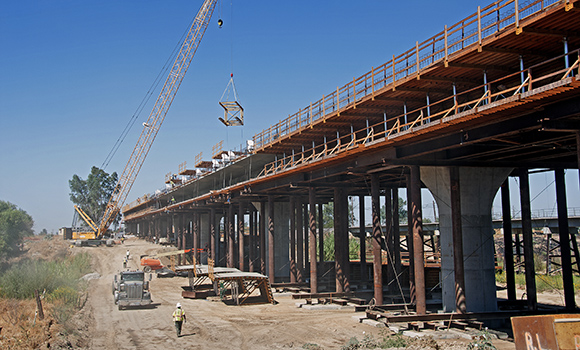
2016 construction of Fresno River Viaduct, one of the first pieces of the California High-Speed Rail system (Photo: CAHSRA)
Beatrice Siaz already had plans to change her life when her husband threw her and their children out of their Corcoran home. She was about to start a pre-apprenticeship training program and nothing was going to stop her.
She was able to stay with a relative and find assistance through the Owens Valley Career Development Center, making it possible to complete the 12-week Valley Apprenticeship Connections training and become one of the first women the program has sent to become a union laborer.
“The day that we had a little graduation for them, she made all of us cry,” recalled Lydia Gutierrez, director of Valley Apprenticeship Connections. “When she came up to receive her certificate of completion and her certificates from the Northern California Laborers, she said, ‘This is for my babies.’ She brought everybody to tears.” Today, Siaz is working on construction sites in and around the Fresno area, making a good wage and supporting her family.
Valley Apprenticeship Connections was founded by Fresno City Councilmember Oliver Baines when it was evident the high-speed rail project would create jobs in the region. “I was asking the high-speed rail authority, the contractors who had been selected to do the work, the apprenticeship programs, 'How do you take a person who lives in my district, for instance, who desires to work in the construction field on high-speed rail—how do you get them involved in the project? How do you get them a job?' And none of them had an answer.”
He created a program for local residents who needed to be trained to qualify for those lucrative union jobs. The program’s target population includes people living in poverty, veterans, minorities, people who have aged out of the foster youth program, people who have been involved in the criminal justice system and anyone who needs a second chance.
Valley Apprenticeship Connections received funding as a sub-contractor through the California Apprenticeship Initiative (CAI) Grant for which State Center Community College District (SCCCD) applied. As the fiscal agent, SCCCD pulled together various resources including Valley Apprenticeship Connections, Northern California Laborers and other building trades to make the program successful.
“Providing a pathway to solid paying jobs for people in underserved communities is exactly what the CAI grant program aims to do,” said Dan Sousa, who coordinates apprentice and workforce training programs for SCCCD. “Programs such as Valley Apprenticeship Connections are helping people get trained and enter the workforce, while at the same time, providing much needed skill labor to local projects. It’s gratifying to see a program that will have long-lasting effects on the families and the regional economy.”
The 12-week program includes soft skills training for six weeks and more specific skills courses such as OSHA training and construction fundamentals for six weeks.
“We’re trying to get the students as ready as they can be to be indentured into the labor union,” said Scott Mahar, one of the instructors for the Northern California Laborers. “They’re trying to have more and more of those basic educational requirements co-mingled into the classes that they teach here at the pre-apprenticeship level. So by the time these guys make it to the labor union, they have most, if not all, of the educational requirements.”
Added Gutierrez, “I’ve talked to the some of the contractors who say it cost them about $40,000 to bring in a new apprentice, if they don’t have their certifications and have to pay for them to go get trained. This way, they’re coming to them with all of the certifications, the basic ones that they need in order to get going.”
In its first year of training, the partnership between SCCCD, Valley Apprenticeship Connections and Northern California Laborers has been successful. Of the 60 completers of the program, 41 have been employed in the building trades with almost all of them making $18-$30 per hour.
Gutierrez also does outreach to the local state prison with great success, noting all 51 formerly incarcerated students who started the program completed it and are now employed.
Mahar left a lucrative job as a stock analyst to return to his construction roots and teach aspiring laborers, something he found inspiring. “This specific group seems to recognize that this is a legitimate shot at a life outside of what they would normally have — a life outside of a gang, outside of crime, outside of all those things that they have been conditioned to accept and embrace in their youth. As a whole, this is a much hungrier group of youth than anybody who I’ve dealt with in the past.”
For Baines, the work of Valley Apprenticeship Connections falls into the bigger picture of fighting poverty. “What I know what happens is that, the moment you move a family into a middle class lifestyle from poverty, what they are going to do is reinvest in their families and their kids. We know that we can break systemic poverty. One of the ways we can do that is by insuring that parents have gainful employment.”
And former students, including Siaz, return to the classroom as often as they can to meet and encourage the current students and show them how their lives can be turned around.

